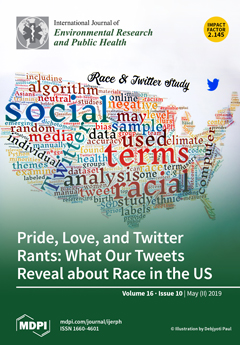To investigate the abundance, water/particle interaction behavior, sources, and potential risk of heavy metals in suspended particulate matter (SPM), a total of 22 SPM samples were collected from the Zhujiang River, Southwest China, in July 2014 (wet season). Nine heavy metal(loid)s (V, Cr,
[...] Read more.
To investigate the abundance, water/particle interaction behavior, sources, and potential risk of heavy metals in suspended particulate matter (SPM), a total of 22 SPM samples were collected from the Zhujiang River, Southwest China, in July 2014 (wet season). Nine heavy metal(loid)s (V, Cr, Mn, Ni, Cu, Zn, As, Cd and Pb) in SPM were detected. The results show that the selected heavy metal(loid)s in SPM appear in the following order: Mn (982.4 mg kg
−1) > Zn (186.8 mg kg
−1) > V (143.6 mg kg
−1) > Cr (129.1 mg kg
−1) > As (116.8 mg kg
−1) > Cu (44.1 mg kg
−1) > Ni (39.9 mg kg
−1) > Pb (38.1 mg kg
−1) > Cd (3.8 mg kg
−1). Furthermore, both the enrichment factor (EF) and geo-accumulation index (I
geo) indicate that SPM is extremely enriched in metal(loid)s of Cd and As, while SPM is slightly enriched, or not enriched, in other heavy metals. According to the toxic risk index (TRI) and hazard index (HI), arsenic accounts for the majority of the SPM toxicity (TRI = 8, 48.3 ± 10.4%) and causes the primary health risk (HI > 1), and the potential risks of V and Cr are also not negligible. By applying a correlation matrix and principal component analysis (PCA), three principal components (PC) were identified and accounted for 79.19% of the total variance. PC 1 (V, Cr, Mn, Ni, Cu, and Pb) is controlled by natural origins. PC 2 (As and Cd) is mainly contributed by anthropogenic origins in the basin. PC 3 (Zn) can be attributed to mixed sources of natural and anthropogenic origins. Moreover, all the partition coefficients (lgK
d) exceeded 2.9 (arithmetical mean value order: Mn > Pb > Cd > V ≈ Cu > Cr ≈ Ni), indicating the powerful adsorptive ability of SPM for these heavy metal(loid)s during water/particle interaction.
Full article





